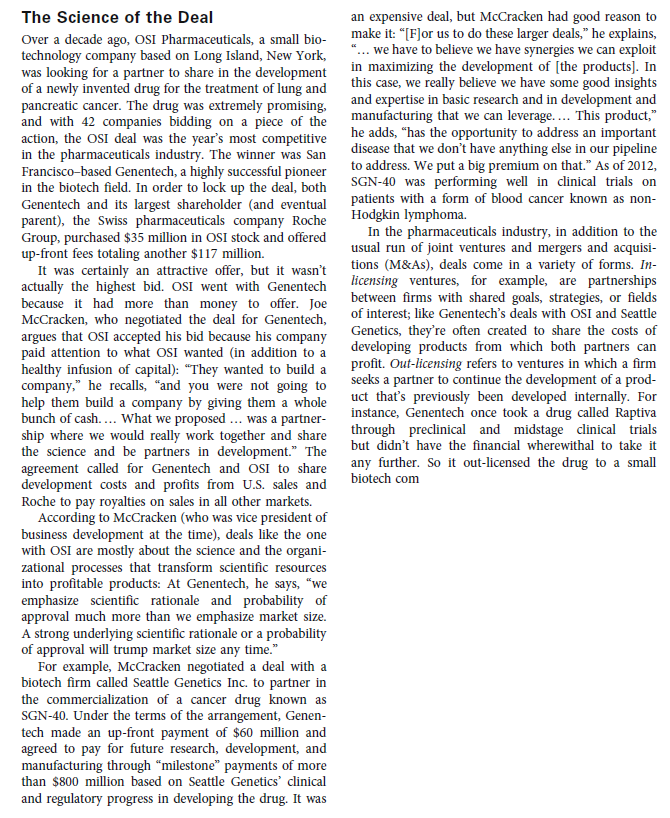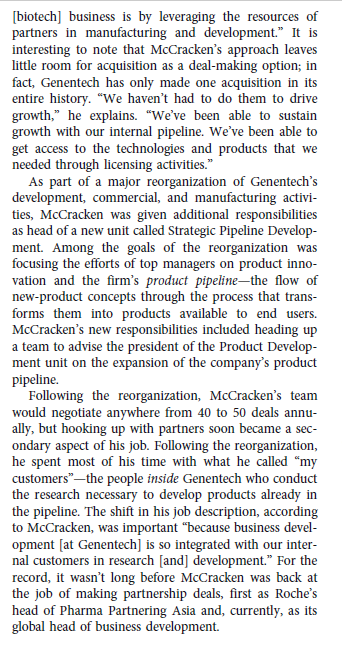Based on this case, could you help me to answer these question?
The Science of the Deal Over a decade ago. lIIII'SI Pharmaceuticals. a small bio technology company based on Long Island. New York. was looking for a partner to share in the development of a newly invented drug for the treatment of lung and pancreatic cancer. The drug was extremely promising. and with 42 companies bidding on a piece of the action. the OSI deal was the year's most competitive In the pharmaceuticals industry. The wirurer was San Franciscobased Genentech. a highly successll pioneer In the biotech eld. In order to lock up the deal. both Genentech and its largst shareholder [and eventual parent]. the Swiss pharmaceuticals company Roche Group. purchased 335 million in 051 stock and offered up-front fees totaling another $11? million. It was certainly an attractive offer. but It wasn't actually the highest hid. DSI went with Genentech because it had more than money to offer. Ioe McCracken. who negotiated the deal for Genentech. argues that 031 accepted his bid because his company paid attention to what 051 wanted [in addition to a healthy infusion of capital}: \"They wanted to build a company." he recalls. \"and you were not going to help them build a company by giving them a whole bunch ofcash.... Whatwe proposed wasaparbier ship where we would really work. together and share the science and be partners in development.\" The agreement called for Genentech and DSI to share development costs and prots om ILLS. sales and Roche to pay royalties on sales in all other markets. According to MoGracken [who was vice president of business development at the time}. deals like the one with 051 are mostly about the science and the organi sational processes that transform scientic resources Into protable products: At Genentech. he says. \"we emphasize scientic rationale and probability of approval much more than we emphasize market size. a strong underlying scientic rationale or a probability of approval will trump market size any time." For example. McGracken negotiated a deal with a biotech rm called Seattle Genetics Inc. to partner in the commercialization of a cancer drug lcnown as SIGN4t}. Under the terms of the arrangement. Genen tech made an up-front payment of S60 million and agreed to pay for future research. development. and manufacturing through \"milestone\" payments of more than $800 million based on Seattle Genetics' clinical and regulatory progress in developing the drug. It was an expensive deal. but McCrarken had good reason to make it: n'[F]or us to do these larger deals." he explains. \". .. we have to believe we have synergies we can exploit in mardmiring the development of [the products]. In this case. we really believe we have some good Insights and expertise in basic research and in development and manufacturing that we can leverage. This product.\" he adds. \"has the opportunity to address an iroportant disease that we don't have anything else in our pipeline to address. We put a big premium on that" As of 2012. SEN-40 was performing well in clinical trials on patients wii a rm of blood cancer known as non Hodglcin lymphoma In the pharmaceuticals industry. in addition to the usual run of joint ventures and mergers and acquisi tions {Hess}. deals come in a variety of forms. In- iicensfng ventures. for example. are partnerships between rms with shared goals. strategies. or elds of interest; like Genentech's deals with 051 and Seattle Genetics. they're often created to share the costs of developing products from which both parbiers can prot. Outlicensing refers to ventures in which a rm seeks a partner to continue the development of a prod uct iat's previously been developed Internally. For instance. Genentech once took a drug called Rapttva through preclinical and midstage clinical trials but didn't have the nancial wherewithal to take it any further. So it outlicensed the drug to a small biotech com [biotech] business is by leveraging the resources of partners in manufacturing and development." It is interesting to note that Mccracken's approach leaves little room for acquisition as a deal-making option; in fact, Genentech has only made one acquisition in its entire history. "We haven't had to do them to drive growth," he explains. "We've been able to sustain growth with our internal pipeline. We've been able to get access to the technologies and products that we needed through licensing activities." As part of a major reorganization of Genentech's development, commercial, and manufacturing activi- ties, Mccracken was given additional responsibilities as head of a new unit called Strategic Pipeline Develop- ment. Among the goals of the reorganization was focusing the efforts of top managers on product inno- vation and the firm's product pipeline-the flow of new-product concepts through the process that trans- forms them into products available to end users. Mccracken's new responsibilities included heading up a team to advise the president of the Product Develop- ment unit on the expansion of the company's product pipeline. Following the reorganization, Mccracken's team would negotiate anywhere from 40 to 50 deals annu- ally, but hooking up with partners soon became a sec- ondary aspect of his job. Following the reorganization, he spent most of his time with what he called "my customers"-the people inside Genentech who conduct the research necessary to develop products already in the pipeline. The shift in his job description, according to Mccracken, was important "because business devel opment [at Genentech] is so integrated with our inter- nal customers in research [and] development." For the record, it wasn't long before Mccracken was back at the job of making partnership deals, first as Roche's head of Pharma Partnering Asia and, currently, as its global head of business development








